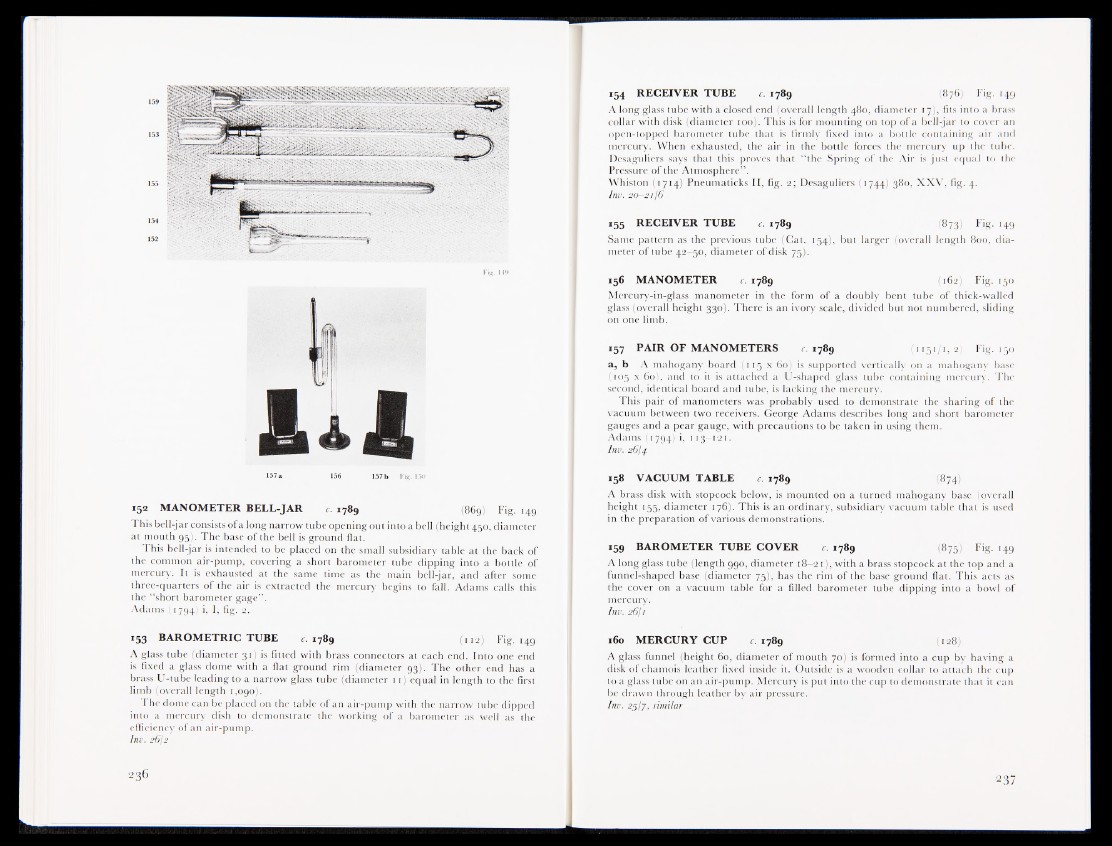
157 a 156 157 b Fig. 150
152 MANOMETER BELL-JAR c. 1789 (869) Fig. 149
This bell-jar consists ofa long narrow tube opening out into a bell (height 450, diameter
at mouth 95). The base of the bell is ground flat.
This bell-jar is intended to be placed on the small subsidiary table at the back of
the common air-pump, covering a short barometer tube dipping into a bottle of
mercury. It is exhausted at the same time as the main bell-jar, and after some
three-quarters of the air is extracted the mercury begins to fall. Adams calls this
the “short barometer gage” .
Adams (1794) i, 1, fig. 2. 153
153 BAROMETRIC TUBE 77. 1789 (112} Fig. 149
A glass tube (diameter 31) is fitted with brass connectors at each end. Into one end
is fixed a glass dome with a flat ground rim'(diameter 93}. The other end has a
brass U-tube leading to a narrow glass tube (diameter 11) equal in length to the first
limb (overall length 1,090).
The dome can be placed on the table of an air-pump with the narrow tube dipped
into a mercury dish to demonstrate the working of a barometer as well as the
efficiency of an air-pump.
Inv. 26)2
154 RECEIVER TUBE c. 1789 (876) Fig. 149
A long glass tube with a closed end (overall length 480, diameter 1 7), fits into a brass
collar with disk (diameter 100). This is for mounting on top of a bell-jar to cover an
open-topped barometer tube that is firmly fixed into a bottle containing air and
mercury. When exhausted, the air in the bottle forces the mercury up the tube.
Destiguliers says that/phis proves that “ the Spring of the Air is just equal to the
Pressure of the Atmosphere” .
Whiston (1714) Pneumaticks II, fig. 2; Desaguliers (1744) 380, XXV, fig. 4.
Inv. 20—21)6
155 RECEIVER TUBE c. 1789 (873) Fig. 149
Same pattern as the previous tube (Cat. 154), but larger (overall length 800, diameter
of tube 42—50, diameter of disk 75).
156 MANOMETER c. 1789 (162) Fig. 150
Mercury-in-glass manometer in the form of a doubly bent tube of thick-walled
glass (overall height 330). There is an ivory scale, divided but not numbered, sliding
on one limb.
157 PAIR OF MANOMETERS c. 1789 (1151/1,2) Fig. 150
a , b A mahogany board (115 x 60) is supported vertically on a mahogany base
(105 x 60), and to it is attached a U-shaped glass tube containing mercury. The
second, identical board and tube, is lacking the mercury.
This pair of manometers was probably used to demonstrate the sharing of the
vacuum between two receivers. George Adams describes long and short barometer
gauges and a pear'gauge, with precautions to be taken in using them.
Ada ms.;(1794.) i, 113—121.
Inv. 26)4
158 VACUUM TABLE c. 1789 (874)
A brass disk with stopcock below, is mounted on a turned mahogany base (overall
height 155, diameter 176). This is an ordinary, subsidiary vacuum table that is used
in the preparation of various demonstrations.
159 BAROMETER TUBE COVER c. 1789 (875) Fig. 149
A long glass tube (length 990, diameter 18 i i ) , with a brass stopcock at the top and a
funnel-shaped base (diameter 75), has the rim of the base ground flat. This acts as
the cover on a vacuum table for a filled barometer tube dipping into a bowl of
mercury.
Inv. 26/1
160 MERCURY CUP c. 1789 (128)
A glass funnel (height 60, diameter of mouth 70) is formed into a cup by having a
disk of chamois leather fixed inside it. Outside is a wooden collar to attach the cup
to a glass tube on an air-pump. Mercury is put into the cup to demonstrate that it can
be drawn through leather by air pressure.
Inv. 25/7, similar